Items
Tag is exactly
student
-
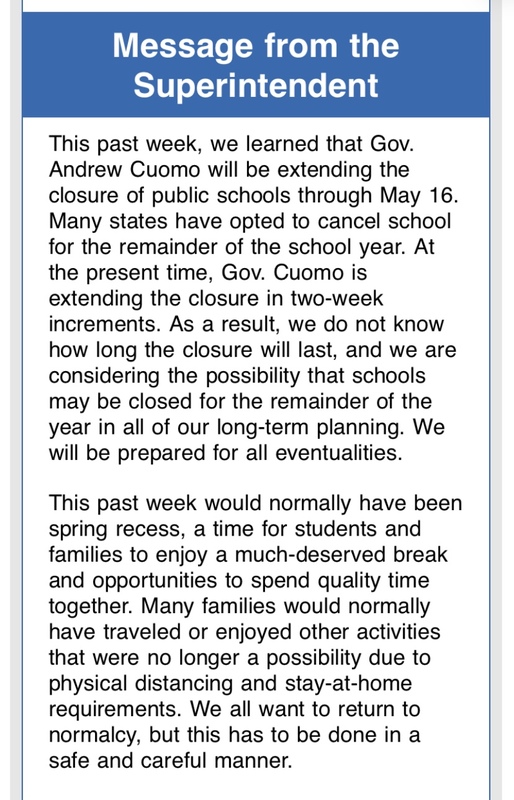 2020-03-20
2020-03-20School Closings
Most people thought that we were getting an extra two weeks off of school and that this covid "thing" would blow over. Everyone thought this was short term and nobody expected to not be in schools for a year and a half and have their lives rearranged. -
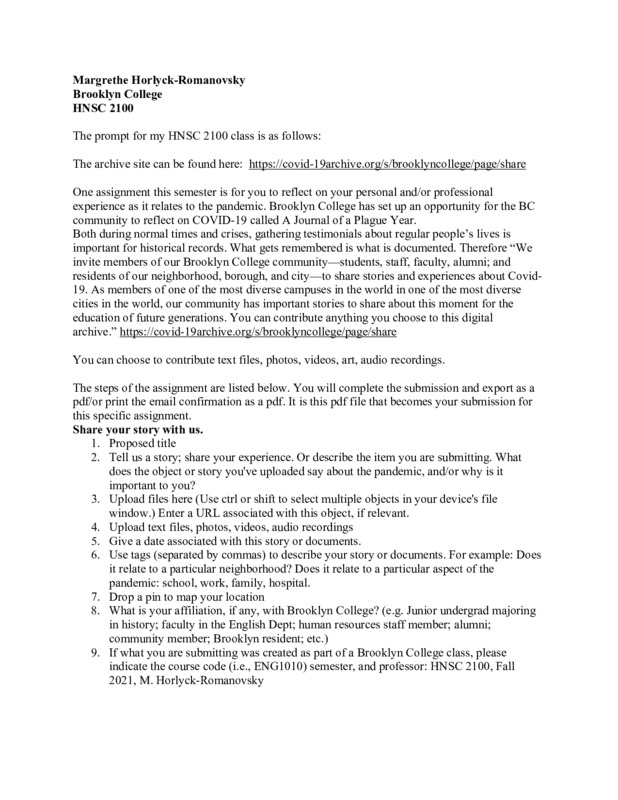 2020
2020Brooklyn College HNSC Prompt
Brooklyn College HNSC assignment prompt, taught by Margrethe Horlyck-Romanovsky -
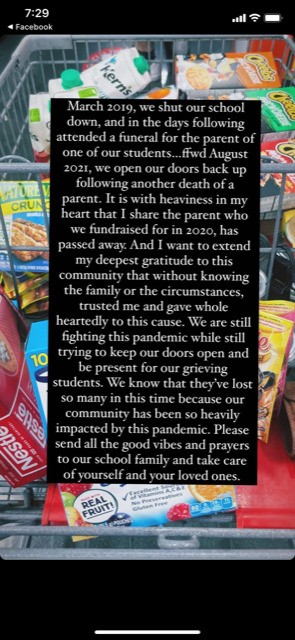 2021-08-16
2021-08-16from the eyes of a teacher
A friend of mine is a teacher for the Los Angeles School District. She shared on social media how Covid has impacted her school and its students. -
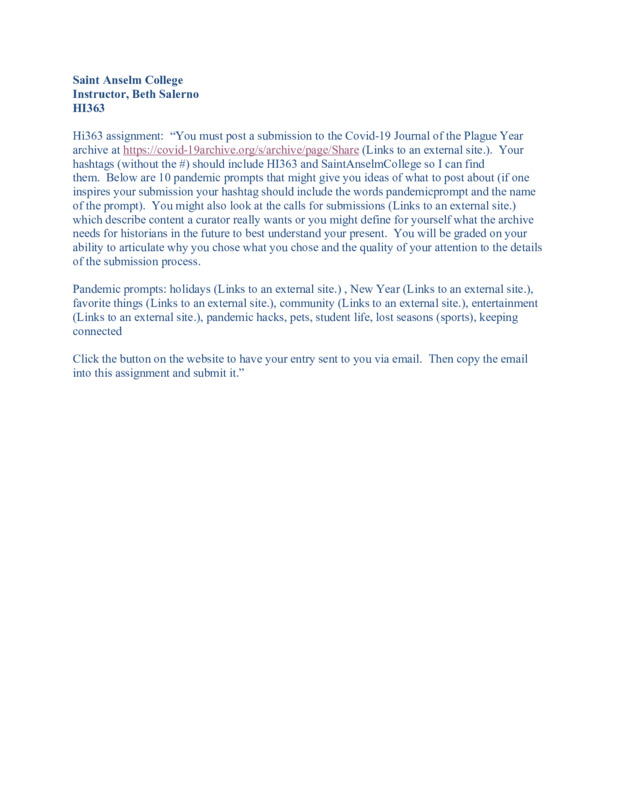 2021
2021Saint Anselm College HI363 prompt
Saint Anselm HI363 student prompt, Spring 2021, instructor Beth Salerno. -
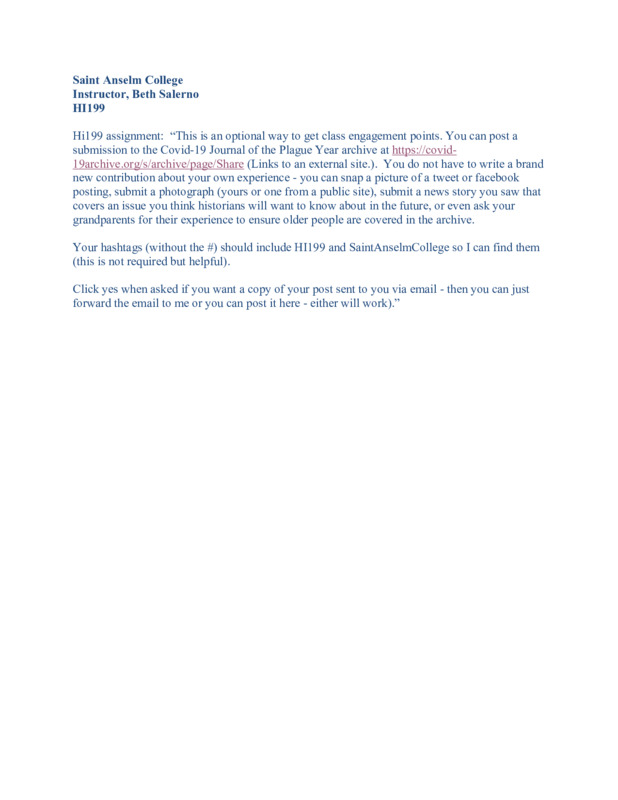 2021
2021Saint Anselm College HI199 prompt
Saint Anselm College HI199 assignment prompt, Spring 2021. Instructor Beth Salerno -
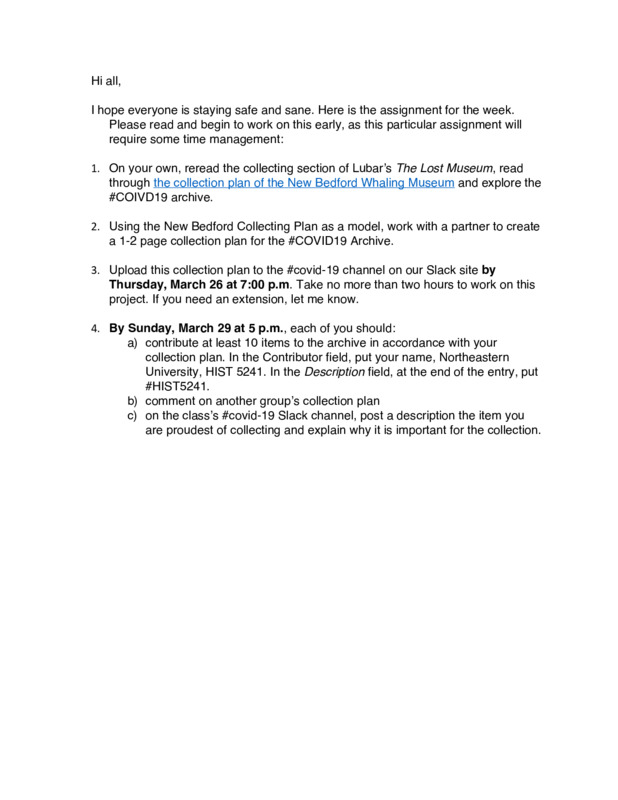 2020
2020HIST 5241 Northeastern Prompt
Prompt given to partner class HIST 5241 of Northeastern University, Spring 2020, instructor Victoria Cain -
 2021
2021Six Room Poem, Franklin Elementary
Paula Flynn's 5th grade class at Franklin Elementary School, in Santa Monica, CA. "Six Room Poem" template provided by Paula Goodman. -
 2020
2020HS 3390A Cover Your Fangs St. Mary's University Lesson Plan
Assignment prompt given to St. Mary's University Students in HS 3390A taught by Lindsey Passenger, Fall 2020 -
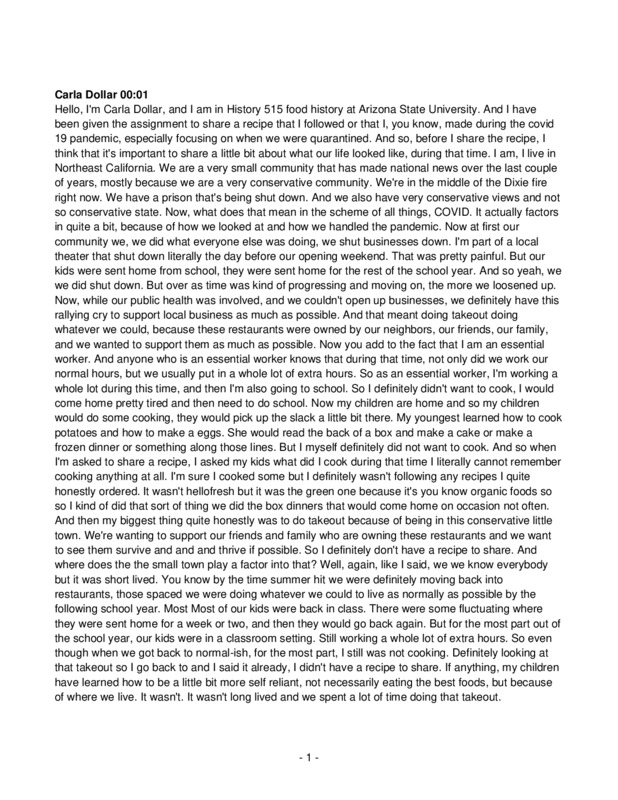 2020-03
2020-03Carla Dollar Oral History, 2020/03
I was given the assignment to share a recipe I made during quarantine that started March 2020. However, the reality was that as an essential worker, I had no time to cook. And in my tiny, conservative town, we rallied together to support local business. We ordered more take-out foods during that time, to support our friends and family who owned restaurants, but also, just didn't have time to cook. -
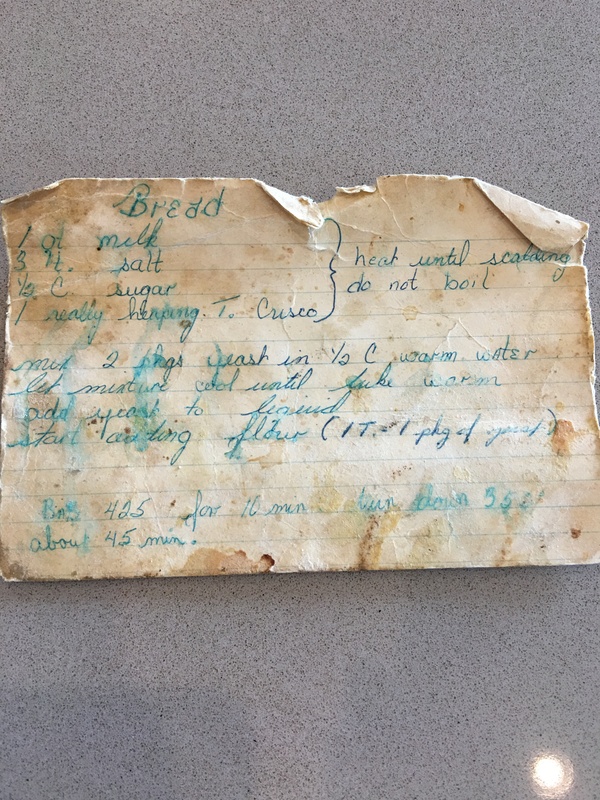 2020-03
2020-03Baking: Impossible
Back in December of 2019, my wife and I were visiting my parents and grandparents in Mesa, Arizona. It was Christmas time, so we were enjoying a bit of leisure time that we typically didn't have. I had just graduated from Brigham Young University-Idaho with a degree in History Education, and my wife just finished a rigorous semester in her study of English at the same school. We were ready for a break. Before meeting up with the family, my grandmother brought up the idea to teach my wife and I how to make homemade bread. It was her grandmothers recipe, and I loved it, as she would occasionally make the dough to make scones or kraut biscuits. This particular recipe made a lot of dough and needed to rise three times. Because of this, making bread was an all day event. Just a few short months after learning to make bread in my grandmother's kitchen, COVID-19 shut down the world. We were living in Rexburg, Idaho at the time-a small town of around 28,000 people located in south-east Idaho. Given that we were in a rural location, we didn't feel the immediate effects of the virus like Seattle, New York City, and Los Angeles. However, around early March, schools shut down and we were told to stay indoors whenever possible. Given that I was a teacher, I was suddenly learning how to run applications like Google Classroom to teach from home. The school district wasn't sure how long I would be working from home for. Initially, they only wanted to close for two weeks to deep clean the school. However, this ended up lasting through the end of the school year. My wife was now also at home. Her studies switched from in-person courses to online courses. Professors who had spent their life in the classroom were suddenly figuring out how to teach via a new medium. It was challenging for all, but everyone seemed to be more patient with each other. Given that my wife and I were home, and given that we had more time, we decided that we would make the bread recipe that my grandmother had taught us over Christmas break. Everyone was encouraged to only shop when absolutely necessary, so we added the flour and yeast to our shopping list. However, when we went shopping only a few days later, the baking isle had been decimated. The only types of flour that were left were expensive bags of specialty flour that came in much smaller portions. Yeast was nowhere to be found. Even things like baking soda were gone. When I think back to the early days of the pandemic, I think of panic. While my wife and I were able to remain calm, many people worried they would not be able to find basic necessities. Grocery stores ran short on many items-toilet paper, canned food, flour, sugar, paper towels, cleaning supplies, amongst other things. Many things that were taken for granted were now an uncertainty. So while we did have more time on our hands, baking bread wasn't an option. -
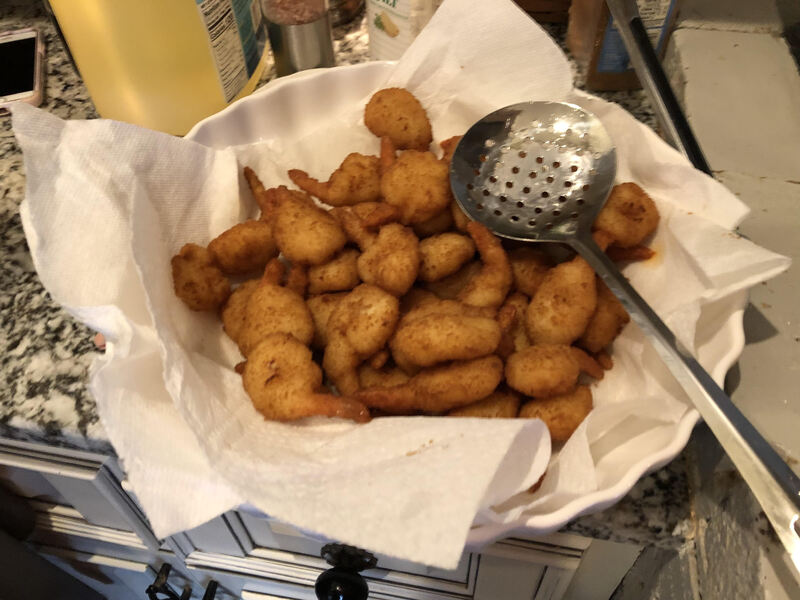 2020-03-14
2020-03-14One Last Family Gathering
The world changed as we Alabamians knew it on Friday, March 13th, 2020, as that was the last day that our school systems remained physically open before our governor mandated forced early system closures ahead of the approaching COVID pandemic. As a high school teacher, I uneasily said goodbye to my students and promised to see them on ZOOM the following Monday. When I arrived home, I found that my wife had contacted each of her family members to invite them to a seafood feast planned in our home for the next day, Saturday the 14th. We had recently purchased a tremendous variety and quantity of seafood for a planned early summer river gathering, including shrimp, crawfish, and fish; however, the pandemic was likely not going to allow for such a future gathering, and we knew of no way in which we could consume so much seafood ourselves, and were equally incognizant when we might gather as a family again, so this was essentially planned as a “McRight family last supper” (pardon the blasphemy, but that’s how we coined it). We had prepared each of the dishes before, save for Tamsie’s new experiment, her crawfish cheesecake. We had enjoyed crawfish and shrimp cheesecake at a wonderful restaurant, Roux 66, while traveling through Natchez, Mississippi several months previous; that culinary experience informed our desire to recreate the recipe at home! Thus, our sensory memory of better times and a delicious meal beckoned us to return to that sensory experience and give the recipe a try. We researched online recipes to combine basic ingredients, including shrimp, crawfish, cream cheese, onions, eggs, and bell peppers, with two cheeses, minced garlic, Creole seasoning, salt and pepper, heavy cream, and a shrimp boil mix. The cheesecake was delicious, and the combination of garlic, crawfish, and shrimp contrasted with the sweet richness of the cream and eggs to make for a delightful dish. To this day, the smell of shrimp makes me think of those early days of the pandemic because our kitchen was filled with the aroma of that decadent crawfish cheesecake, shrimp scampi, a shrimp boil, fried fish, boiled shrimp, and fried shrimp. We hosted approximately twenty-five family members, we laughed, we talked about the future, and we expressed concern over what the coming days might bring. Afterward, we dismissed pandemic talk to release our concerns for the shank of the evening, as we were living for the moment and celebrating our being together. I remember thinking but it might be a long time before we could get fresh seafood again, because we did not know if the opportunity to find fresh seafood would avail itself again in the near future, nor did we know if grocery stores would remain open. That was a time of complete uncertainty. I will likely never again enjoy a shrimp meal without thinking about March 14th, 2020, as the world in which we had lived mere days before somehow now seemed different, foreign, and unsettling. -
 2020
2020H396 University of San Francisco prompt
Prompt given to University of San Francisco students in H396, taught by Kathryn Nasstrom -
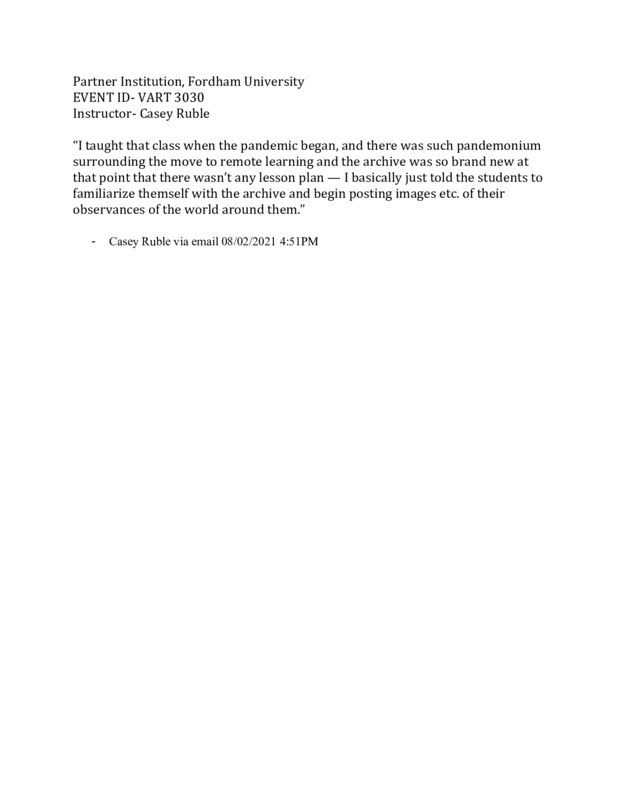 2020
2020VART 3030 Fordam University, email of assignment prompt
Email from Casey Ruble, an instructor at Fordham University, VART 3030. Asked students to "familiarize themself with the archive and begin posting images etc. of their observances of the world around them." Students submitted to archive during the Spring semester 2020 -
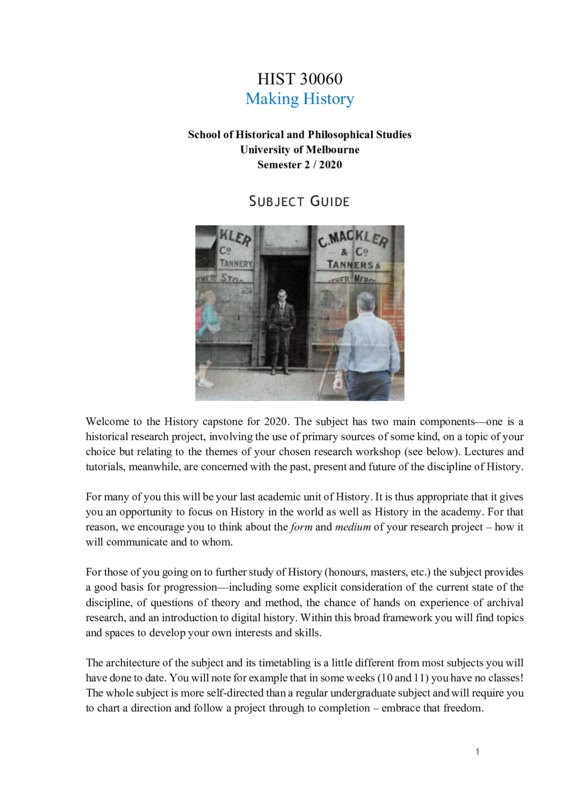 2020
2020HIST 30060 University of Melbourne Syllabus
The syllabus given to students of partner class HIST 30060 of the University of Melbourne by instructor Andrew May, Fall 2020. -
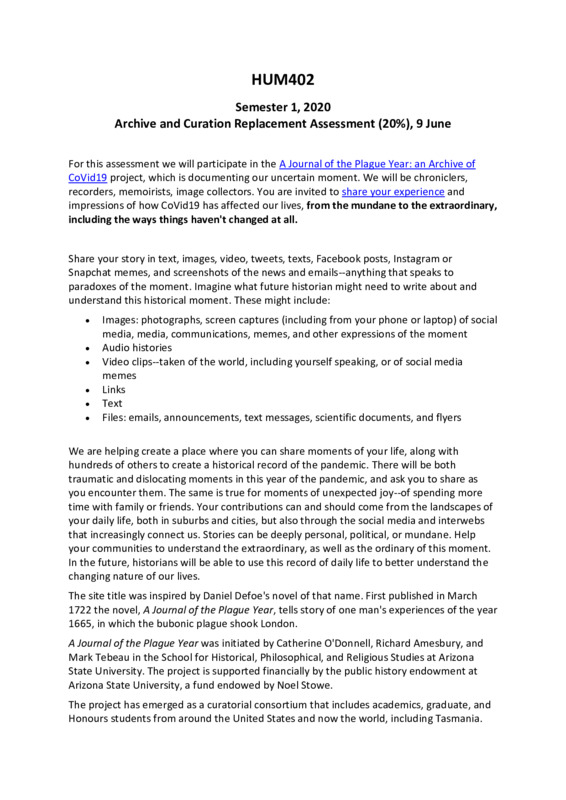 2020
2020HUM 402 assignment prompt, University of Tasmania
Assignment prompt given to University of Tasmania students in HUM 402 by instructor Nicole Tarulevicz -
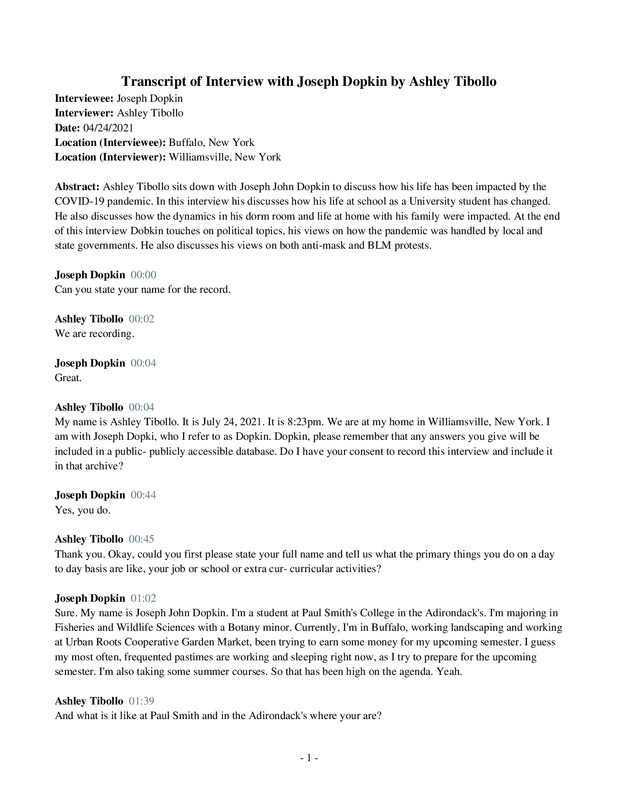 2021-07-24
2021-07-24Joseph Dopkin, Oral History 2021/07/24
Ashley Tibollo sits down with Joseph John Dobkin to discuss how his life has been impacted by the COVID-19 pandemic. In this interview his discusses how his life at school as a University student has changed. He also discusses how the dynamics in his dorm room and life at home with his family were impacted. At the end of this interview Dobkin touches on political topics, his views on how the pandemic was handled by local and state governments. He also discusses his views on both anti-mask and BLM protests. -
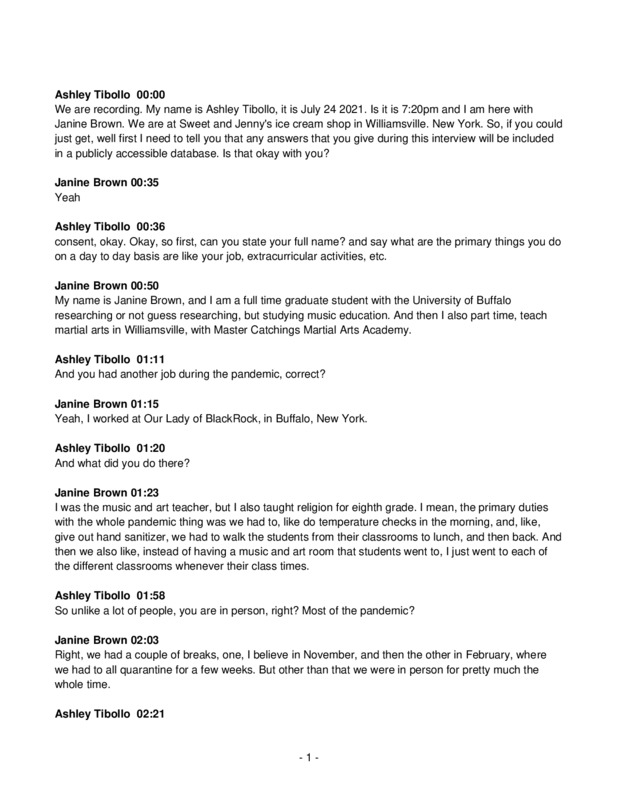 2021-07-24
2021-07-24Janine Brown. Oral History, July 24, 2021
In this two-part interview, Ashley Tibollo interviews Janine Brown on how her life was impacted by the Covid-19 pandemic. In the first part of the interview, Brown discusses how her last year of college was impacted and about her transition to remote teaching. She discusses her fears of the Delta variant, what sources she uses to get her information and what her feelings are regarding government action. She also discusses family life and how she was affected by the quarantine. She ends this part with her hopes for the future. In the second part of this interview, Brown discusses her decision to move in with her boyfriend right before quarantine and what it was life navigating a new relationship amidst a pandemic. She also discusses her pets and how their moods changed as her life changed. She discusses the difficulties of house hunting and the ways that the pandemic has affected the market. -
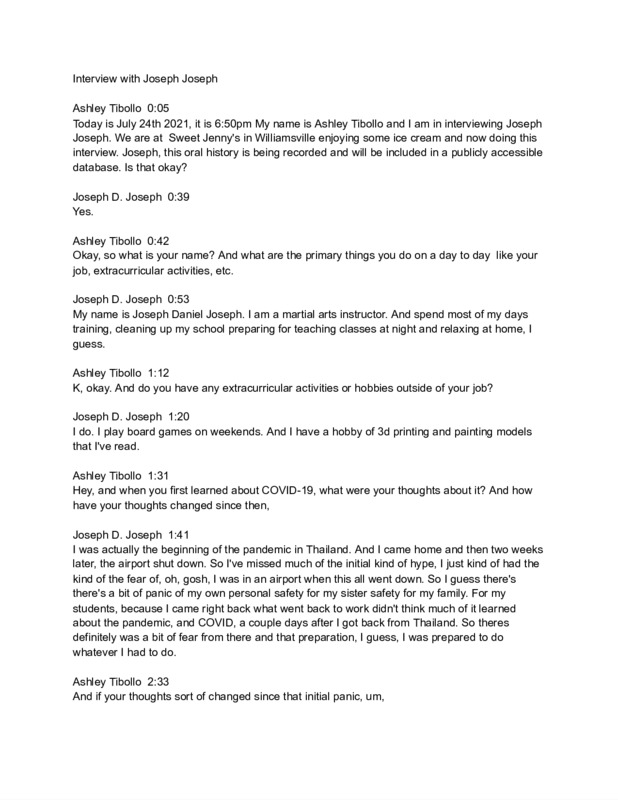 2021-07-24
2021-07-24Joseph D. Joseph, Oral History, July 24, 2021
Ashley Tibollo sits down with Joseph D. Joseph in an ice cream shop in Buffalo, New York to discuss how his life has been affected by the COVID-19 pandemic. In this interview, Joseph describes changes in his day-to-day routine, his life as a martial arts instructor, and changes in his economic status. He also discusses his students and how the pandemic affected them. In the last part of this interview, Joseph discusses his views on politics and what he hopes the future generations will learn about the response to this pandemic. -
 07/22/2021
07/22/2021Research shows COVID-19 link to heart damage
Banner Health experts are encouraging cardiac screenings for student-athletes as new research has revealed potential heart damage as a potential after effect from COVID-19 infection. -
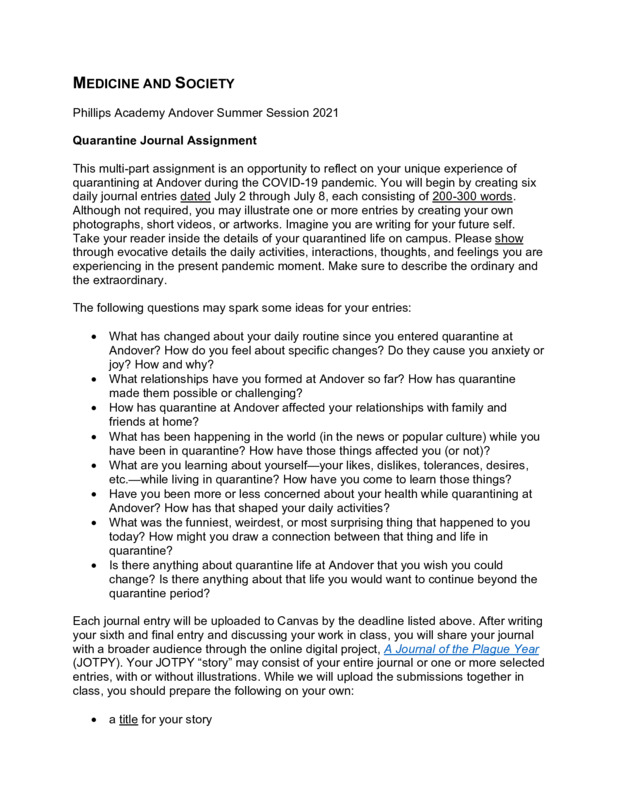 2021-07-10
2021-07-10Quarantine Journal Assignment at Andover Summer
While students in the 2021 on-campus summer program at Phillips Academy Andover quarantined on campus for one week, I asked those enrolled in my "Medicine and Society" course to keep a journal in which they reflected on how their daily experiences were shaped by the program's COVID protocols. Those protocols included universal masking (indoors and outdoors), social distancing, grab-and-go food service, regular PCR testing, and more. For their JOTPY stories, some students chose to upload their entire journals, while others summarized their reflections over the week. On the day we uploaded our stories, the quarantine period came to end, and the students could enjoy a bit more social freedoms on and off campus. -
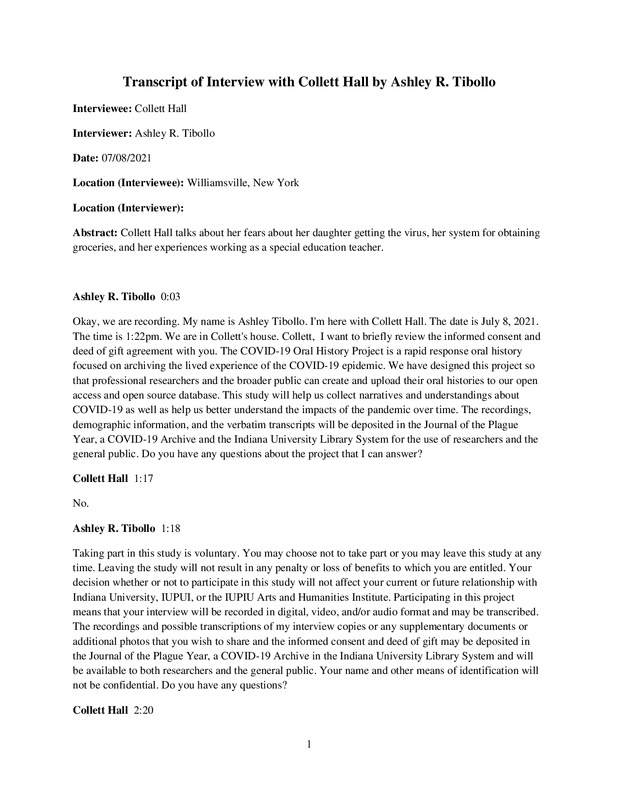 07/08/2021
07/08/2021Collett Hall Oral History, 2021/07/08
Collett Hall talks about her fears about her daughter getting the virus, her system for obtaining groceries, and her experiences working as a special education teacher. -
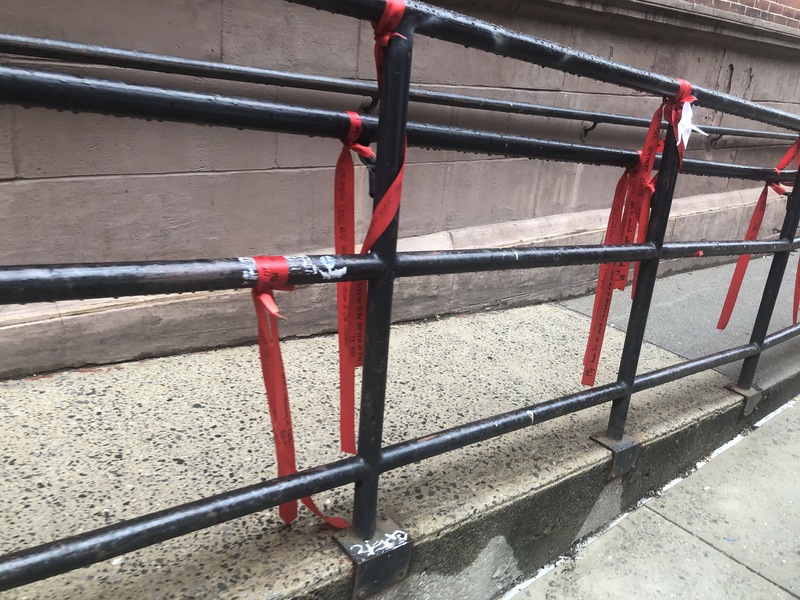 2021-06-13
2021-06-13Red ribbons at P.S. 042 Benjamin Altman
I took these two photos in Downtown Manhattan at Public School 42. There were red ribbons tied around the iron fence that appear to have wishes or hopes from students. Some of the ribbons are hard to read, but one says "[Illegible] make homeless people happy by giving them things I don't need" and another says "My [illegible] that COVID-19 will stop forever". All of the ribbons where the grade level is visible indicate that the ribbons were made by fourth graders. -
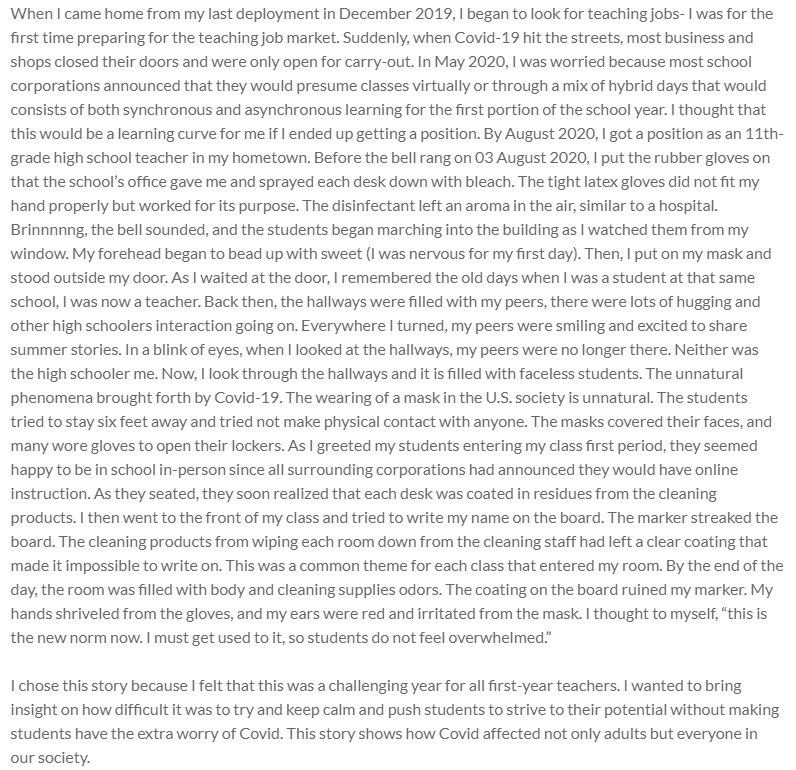 2020-08-03
2020-08-03U.S. History Classroom 2020
When I came home from my last deployment in December 2019, I began to look for teaching jobs- I was for the first time preparing for the teaching job market. Suddenly, when Covid-19 hit the streets, most business and shops closed their doors and were only open for carry-out. In May 2020, I was worried because most school corporations announced that they would presume classes virtually or through a mix of hybrid days that would consists of both synchronous and asynchronous learning for the first portion of the school year. I thought that this would be a learning curve for me if I ended up getting a position. By August 2020, I got a position as an 11th-grade high school teacher in my hometown. Before the bell rang on 03 August 2020, I put the rubber gloves on that the school’s office gave me and sprayed each desk down with bleach. The tight latex gloves did not fit my hand properly but worked for its purpose. The disinfectant left an aroma in the air, similar to a hospital. Brinnnnng, the bell sounded, and the students began marching into the building as I watched them from my window. My forehead began to bead up with sweet (I was nervous for my first day). Then, I put on my mask and stood outside my door. As I waited at the door, I remembered the old days when I was a student at that same school, I was now a teacher. Back then, the hallways were filled with my peers, there were lots of hugging and other high schoolers interaction going on. Everywhere I turned, my peers were smiling and excited to share summer stories. In a blink of eyes, when I looked at the hallways, my peers were no longer there. Neither was the high schooler me. Now, I look through the hallways and it is filled with faceless students. The unnatural phenomena brought forth by Covid-19. The wearing of a mask in the U.S. society is unnatural. The students tried to stay six feet away and tried not make physical contact with anyone. The masks covered their faces, and many wore gloves to open their lockers. As I greeted my students entering my class first period, they seemed happy to be in school in-person since all surrounding corporations had announced they would have online instruction. As they seated, they soon realized that each desk was coated in residues from the cleaning products. I then went to the front of my class and tried to write my name on the board. The marker streaked the board. The cleaning products from wiping each room down from the cleaning staff had left a clear coating that made it impossible to write on. This was a common theme for each class that entered my room. By the end of the day, the room was filled with body and cleaning supplies odors. The coating on the board ruined my marker. My hands shriveled from the gloves, and my ears were red and irritated from the mask. I thought to myself, “this is the new norm now. I must get used to it, so students do not feel overwhelmed.” I chose this story because I felt that this was a challenging year for all first-year teachers. I wanted to bring insight on how difficult it was to try and keep calm and push students to strive to their potential without making students have the extra worry of Covid. This story shows how Covid affected not only adults but everyone in our society. -
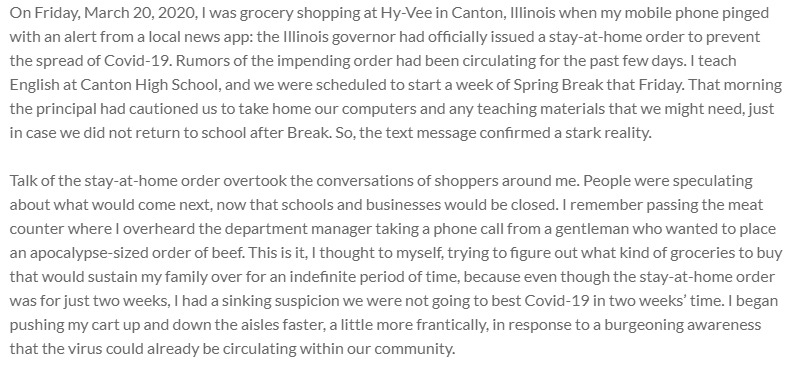 2020-03-20
2020-03-20The Signal of Approaching Silence
On Friday, March 20, 2020, I was grocery shopping at Hy-Vee in Canton, Illinois when my mobile phone pinged with an alert from a local news app: the Illinois governor had officially issued a stay-at-home order to prevent the spread of Covid-19. Rumors of the impending order had been circulating for the past few days. I teach English at Canton High School, and we were scheduled to start a week of Spring Break that Friday. That morning the principal had cautioned us to take home our computers and any teaching materials that we might need, just in case we did not return to school after Break. So, the text message confirmed a stark reality. Talk of the stay-at-home order overtook the conversations of shoppers around me. People were speculating about what would come next, now that schools and businesses would be closed. I remember passing the meat counter where I overheard the department manager taking a phone call from a gentleman who wanted to place an apocalypse-sized order of beef. This is it, I thought to myself, trying to figure out what kind of groceries to buy that would sustain my family over for an indefinite period of time, because even though the stay-at-home order was for just two weeks, I had a sinking suspicion we were not going to best Covid-19 in two weeks’ time. I began pushing my cart up and down the aisles faster, a little more frantically, in response to a burgeoning awareness that the virus could already be circulating within our community. Looking back now, I see that we were somewhat cocooned in Fulton County, Illinois, a mostly rural county. The health department announced the first positive case on April 10; the first death occurred on October 21. The virus was slow to take a foothold, but eventually it did. In late July, our school district’s board unanimously voted to start the school year fully remote. Each school day, teachers reported to ghost-town school buildings and holed up in their empty classrooms, with admonitions from administrators not to co-mingle with each other. During that time, I dutifully logged onto Google Meets for each class period, where various avatars greeted me because students were not required to turn on their cameras, so none did. Sometimes I got to hear tinny student voices, which sounded a lot further away than across town, and I wondered if each voice matched the person I pictured in my mind’s eye. I had never met the majority of my students in person, and the photographs on our school’s student management system had not been updated since the fall of 2019. I remember the frustration I struggled to keep capped when I would call on students and be met with silence. Were they even sitting by the computer? Were they afraid to say something in front of their classmates, lest they look stupid? Were they just willfully ignoring me? Were they okay, physically and mentally? I pulled more words out of students through written assignments and chat boxes than through Google Meets. Although part of the student body returned to in-person school in January of 2021 while the rest remained remote by choice (we taught both groups concurrently), it was still difficult to get students to speak, even to each other. Sadly, many of our students had become so accustomed to the idea of school as a radio broadcast—one from which they could easily disengage if they so wished—that they no longer felt it necessary to contribute their voices. In Illinois, we’ve been told that all students will return to in-person learning in the fall of 2021, with few exceptions, but I fear the virus has done irrevocable damage to our students’ speech. -
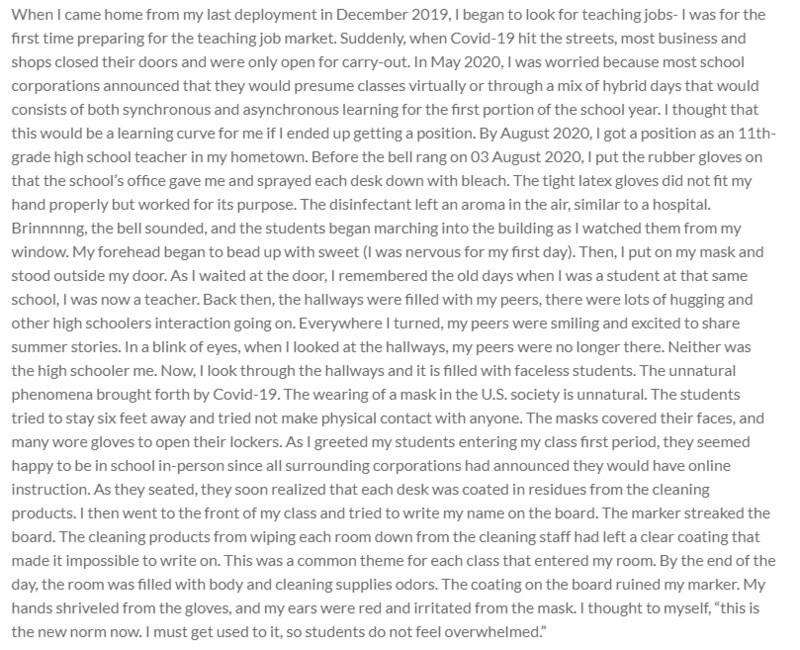 2020-08-04
2020-08-04U.S. History Classroom
When I came home from my last deployment in December 2019, I began to look for teaching jobs- I was for the first time preparing for the teaching job market. Suddenly, when Covid-19 hit the streets, most business and shops closed their doors and were only open for carry-out. In May 2020, I was worried because most school corporations announced that they would presume classes virtually or through a mix of hybrid days that would consists of both synchronous and asynchronous learning for the first portion of the school year. I thought that this would be a learning curve for me if I ended up getting a position. By August 2020, I got a position as an 11th-grade high school teacher in my hometown. Before the bell rang on 03 August 2020, I put the rubber gloves on that the school’s office gave me and sprayed each desk down with bleach. The tight latex gloves did not fit my hand properly but worked for its purpose. The disinfectant left an aroma in the air, similar to a hospital. Brinnnnng, the bell sounded, and the students began marching into the building as I watched them from my window. My forehead began to bead up with sweet (I was nervous for my first day). Then, I put on my mask and stood outside my door. As I waited at the door, I remembered the old days when I was a student at that same school, I was now a teacher. Back then, the hallways were filled with my peers, there were lots of hugging and other high schoolers interaction going on. Everywhere I turned, my peers were smiling and excited to share summer stories. In a blink of eyes, when I looked at the hallways, my peers were no longer there. Neither was the high schooler me. Now, I look through the hallways and it is filled with faceless students. The unnatural phenomena brought forth by Covid-19. The wearing of a mask in the U.S. society is unnatural. The students tried to stay six feet away and tried not make physical contact with anyone. The masks covered their faces, and many wore gloves to open their lockers. As I greeted my students entering my class first period, they seemed happy to be in school in-person since all surrounding corporations had announced they would have online instruction. As they seated, they soon realized that each desk was coated in residues from the cleaning products. I then went to the front of my class and tried to write my name on the board. The marker streaked the board. The cleaning products from wiping each room down from the cleaning staff had left a clear coating that made it impossible to write on. This was a common theme for each class that entered my room. By the end of the day, the room was filled with body and cleaning supplies odors. The coating on the board ruined my marker. My hands shriveled from the gloves, and my ears were red and irritated from the mask. I thought to myself, “this is the new norm now. I must get used to it, so students do not feel overwhelmed.” -
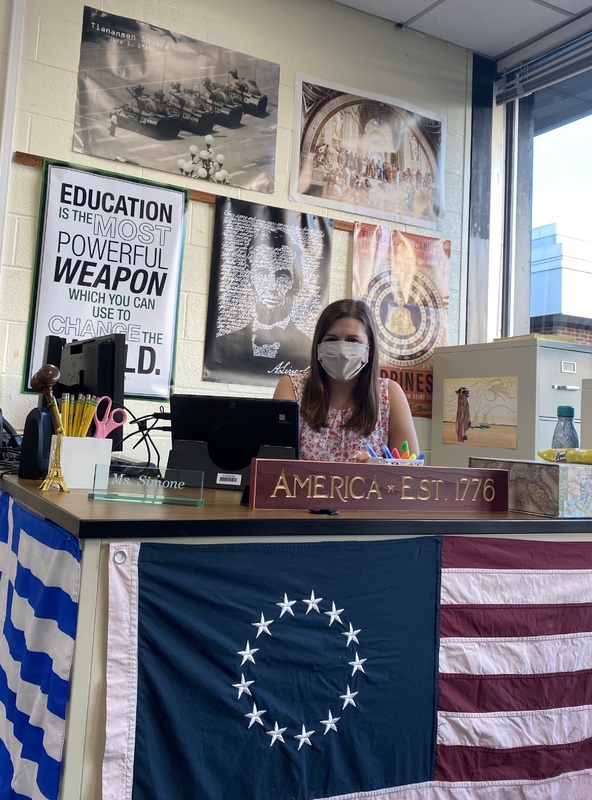 2020-09-08
2020-09-08First Day of School Scents
September 8, 2020 was the first day of school at my regional high school and I was beginning my third year as a teacher. As always, the night before the first day of school was marked by butterflies, but this time around, the butterflies were not due to the excitement and hecticness of the first day, but due to fear. As someone who social distanced to an extent unmatched by most of my peers, coming to school on the first day terrified me, as I was concerned with putting myself around so many other people in such a small room, specifically high school students who certainly enjoyed more social interaction over the summer than I did. However, as a teacher, I had to come in with a smile on my face, as you can see in the picture, despite the immense fear I was feeling in the pit of my stomach. What I remember most clearly is the smell of the school. The hallways were filled with hand sanitizer dispensers which released a scent that could overpower all else. Individual classrooms were packed with cleaning supplies and Lysol wipes which I had to clean each desk with between periods. What is so shocking is that more than anything, it is these smells that I associate with the fear I felt that first day of school. Though that first day was one of the most fear-inducing days of my life, the year ended up being incredibly rewarding and my students and I together helped each other through one o f the mo st difficult years of our lives. Though originally nervous to teach in 2020, I am incredibly grateful to have been able to conquer this year with my students by my side. Hopefully someday I will not have such an adverse reaction to the smell of hand sanitizer. -
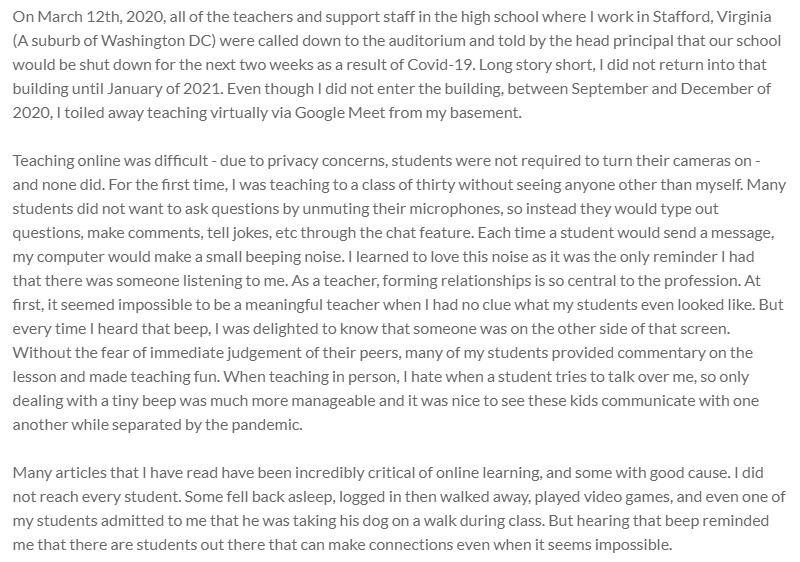 2020-09
2020-09The Sound of Learning - Teaching During the Pandemic
On March 12th, 2020, all of the teachers and support staff in the high school where I work in Stafford, Virginia (A suburb of Washington DC) were called down to the auditorium and told by the head principal that our school would be shut down for the next two weeks as a result of Covid-19. Long story short, I did not return into that building until January of 2021. Even though I did not enter the building, between September and December of 2020, I toiled away teaching virtually via Google Meet from my basement. Teaching online was difficult - due to privacy concerns, students were not required to turn their cameras on - and none did. For the first time, I was teaching to a class of thirty without seeing anyone other than myself. Many students did not want to ask questions by unmuting their microphones, so instead they would type out questions, make comments, tell jokes, etc through the chat feature. Each time a student would send a message, my computer would make a small beeping noise. I learned to love this noise as it was the only reminder I had that there was someone listening to me. As a teacher, forming relationships is so central to the profession. At first, it seemed impossible to be a meaningful teacher when I had no clue what my students even looked like. But every time I heard that beep, I was delighted to know that someone was on the other side of that screen. Without the fear of immediate judgement of their peers, many of my students provided commentary on the lesson and made teaching fun. When teaching in person, I hate when a student tries to talk over me, so only dealing with a tiny beep was much more manageable and it was nice to see these kids communicate with one another while separated by the pandemic. Many articles that I have read have been incredibly critical of online learning, and some with good cause. I did not reach every student. Some fell back asleep, logged in then walked away, played video games, and even one of my students admitted to me that he was taking his dog on a walk during class. But hearing that beep reminded me that there are students out there that can make connections even when it seems impossible. -
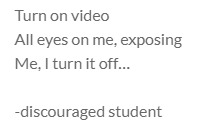 2021-06-23
2021-06-23Blank screens
Turn on video All eyes on me, exposing Me, I turn it off… -discouraged student -
 2021-03-16
2021-03-16Teacher Interview: Avilette de Castro
Middle school Spanish teacher, Avilette de Castro, answers student questions about changes to education in the coronavirus pandemic. Walls: What is your name, grade you teach and school you teach in? de Castro: Avilitte Castro, Sebastian Middle 7-8th grade Spanish Walls: How has the pandemic changed the way you teach? de Castro: So, the biggest thing is that I feel like I haven’t taught enough, like I'm putting stuff out there and it’s not sticking. Before the pandemic there was more engagement and now there isn’t. Especially with those that are DL’s (distance learners). Walls: What was the biggest challenge in the beginning? de Castro: We were not prepared as teachers at all for what we had to do. I had never taught online before and I had to try to adapt everything online. Not everyone showed up. It’s not high school, they don’t think that it counts. They don't realize that even though their grades won't neccessarily carry on to high school, everything else will. Walls: What is the biggest challenge now? de Castro: So now, it’s mostly back to normal in some senses. We haven’t had any kids go into quarantine in awhile and I’m down to only 3 DL’s and I don't know if the kids are fully into it. I always have the thought that we could go back into quarantine. We just adopted a new textbook and I have to tell that book as well. The EOC (End of Course Exam) for this year is being used from this new book. I am adapting everything, but not able to get a hold of everything. I am learning this new book as well as my students. Walls: How do you think students are doing? What are their biggest challenges? de Castro: I don’t think, for me, I really don’t think I’ve taught them as well as I normally do. I hate to say this because it’s not quite bad. Some of my students aren’t doing anything, because they don’t think it will count. The other thing for me, I do a language class. A big part of my class is conversation. I don’t let them work in groups and they aren’t able to get the conversation that they used to get. Right now we are doing a food unit. They don’t get the reaction in conversations. Walls: Do you see anything beneficial coming from the changes you have had to implement? de Castro: Oh yeah. For me, doing stuff with technology has always been supplemental instead of part of the curriculum. Like if I post this you can have it and now everything is online. The kids have access to it online, doesn’t mean the students use the extra resources. I’ve been having to use the textbook website and it’s something that they can do anywhere that they are at. It’s an added resource, so it's a benefit for them. Walls: How has parent involvement changed during the pandemic? de Castro: No, one of my DL’s has his guardian sister with him the whole time and it’s a little nerve racking to have her hear me the whole time. It’s pretty much the same overall. -
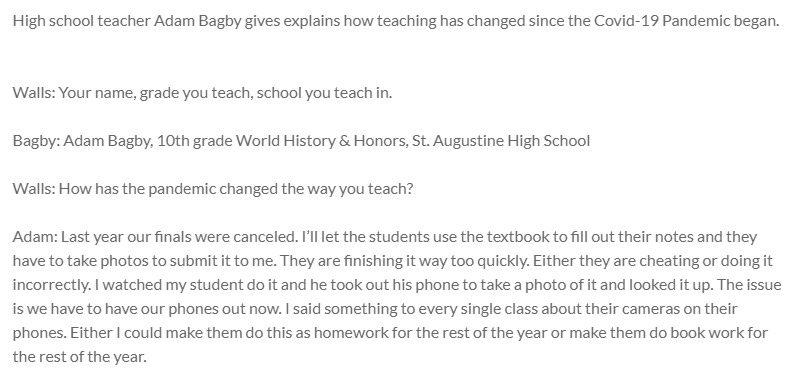 2021-04
2021-04Teacher Interview: Adam Bagby
High school teacher Adam Bagby gives explains how teaching has changed since the Covid-19 Pandemic began. Walls: Your name, grade you teach, school you teach in. Bagby: Adam Bagby, 10th grade World History & Honors, St. Augustine High School Walls: How has the pandemic changed the way you teach? Adam: Last year our finals were canceled. I’ll let the students use the textbook to fill out their notes and they have to take photos to submit it to me. They are finishing it way too quickly. Either they are cheating or doing it incorrectly. I watched my student do it and he took out his phone to take a photo of it and looked it up. The issue is we have to have our phones out now. I said something to every single class about their cameras on their phones. Either I could make them do this as homework for the rest of the year or make them do book work for the rest of the year. Walls: What was the biggest challenge in the beginning of the pandemic when classes were remote? Bagby: The exact same challenge from beginning to now that is not solvable. Students will log in and during our instruction I’ll call on a student and they wouldn’t be on the computer. I would mark them absent. I would get parent phone calls and emails. Walls: What is the biggest challenge now? Bagby: The buy in for students from home. I’ll even tell my students to text their friends Walls: How do you think students are doing? What are their biggest challenges? Bagby: My issue is for my students to remember turning in their work online. Some are doing worse because they aren’t able to hand in an assignment. I had some students who enrolled online, but they are working during the day to help their families out with bills. It seems like there’s a lot more stress than there should be. There are some students who have the discipline who can sit down at the computer and do the work, but some students can’t do that at all. I have 2 students I have not seen at all. It’s a blessing and a curse. You can do well with it or not. It all depends on your home situation. Walls: Do you see anything beneficial coming from the changes you have had to implement? Bagby: I saw this happening last year, so I put everything online early. I’ve been teaching for 7 years, so I always knew how important technology is in education. I think online integration is going to be permanent, like Schoology. There obviously needs to be a better platform. Walls: Are you noticing a change in parent involvement? Bagby: Oh yeah. They’re not there. I haven’t had any complaints. Most parents have been understanding. -
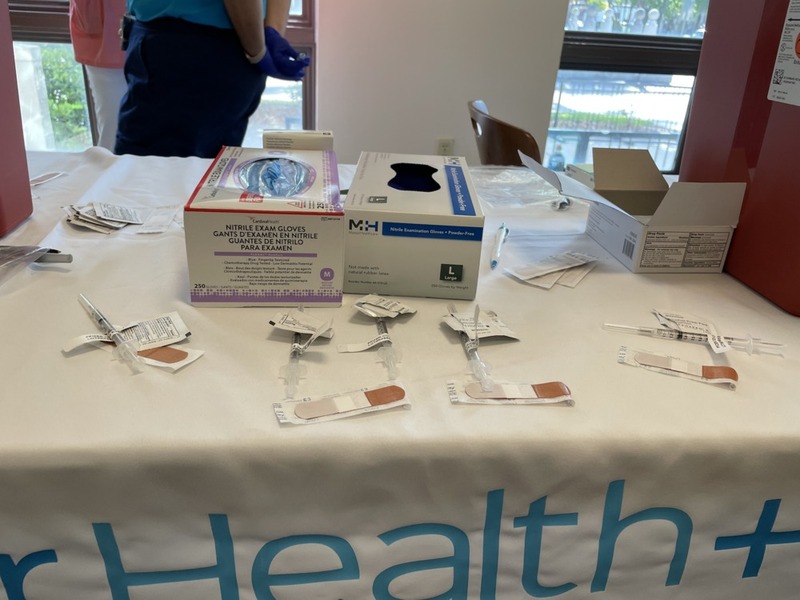 2021-04-28
2021-04-28Vaccine On Campus
As a year has passed from the beginning of the pandemic, Flagler College has partnered with Flagler Health to offer the Pfizer vaccine for students over eighteen. Staff and faculty were also offered the vaccine in a separate event. -
 2021-06-04
2021-06-04Truth during our COVID PANDEMIC
Through this Pandemic, I personally had to mature past the age I currently am. Now having to take on such a huge responsibility to be safe and avoid as many people as possible, it really took a toll on my social skills. Especially for someone who had problems with anxiety, I found some peace and salvation being around and talking with the people I liked. now having to avoid them? Well, that was one big change. Although it was hard at first, I encourage whoever sees and reads this to embrace change and curve it to your steering. After all, I overcame my anxiety through this quarantine. Some people may say COVID has affected them in ways they may not recover from but I just assume that it is all adults speaking. I have grown as a person and have actually realized the small little injustices that happened to students and the misleading nature of the "system'. At this time, this era, highlights of racial acts have now shown itself as if you sprayed insects with raid pesticide. Surprisingly, it was more common in Police Departments believe it or not. The people who swore to protect and serve justice were the ones who were at the epicenter of injustice. Schools no longer served students but rather misled them into thinking they were being helped. The first I would love to emphasize on is the fact that nothing they simply teach us in school relates to anyone's lifestyle. Sure if you went the technical route to want a specific occupation it was helpful, but other than that, it was absolutely useless. As a straight A student, I found myself in "unknown" territory when I was outside of school. Nothing of what we were taught is to be put in use. We don't solve x to make a U turn, we don't need to do an entire analysis on a red stop light to know that it says stop and we certainly didn't need to know that the rocks that we kick on our walks to home are sedimentary rock or igneous rocks. The education system is flawed in helping individuals learn what they need to know. Handing out 7 different subjects when your goal is to be a computer engineer? that doesn't seem right does it? I'm sure you said yes and you are now beginning to see my point. A few months back, February 14, 2021, information was leaked on the edu system. These tests that they give us, these regents and state exams.. it's all a cover up to their hunger for money. They lie to us that our performance on the tests dictates whether or not we pass but that's not the case. It actually dictates how well the school is funded and how much the teachers are paid. YOUR TESTS.. they aren't doing anything for you. The better you perform, the central host that funds schools, uses that information and says "oh wait.. this school performed well. Lets fund them more and pay the teachers better for their *HARD WORK*" These things don't help us. That is why America Continues to see their homeless individual growth rate increase every year. The people are conditioned to do good on selecting a, b , c or d but have no idea how to get a job, do their taxes, get a business loan in real life!!.This problematic system needed to be changed and for my time, it won't. I hope that someone in the future sees this and does a comparison and contrasts on how things have changed or if it has even changed at all. I apologize for the long rant on school at this time, it's just at the center of all the youths' problems currently. Back on track to injustices here present. If we were to take a step back and really look at the racial events partaking currently, we begin to see how one of the most notorious orgs that stands against racism is to be considered a terrorist org. That is the BLM foundation. Now you may have thought that they do good, but I assure you it isn't what it seems. Let's first analyze what makes an organization a terrorist foundation. 1) The people sway from the cause and place the blame on someone else 2) propaganda is at the forefront of the organization 3) they destroy and hurt lives more than they help. Let's compare al Queda to BLM. al queda, the organization that was behind the 9/11 incident is no less different from BLM. 1) Al Queda sole purpose was to send a message to the US saying that they will fight back at any US involvement in the Middle east. They swayed from that and blamed all their actions on the US including the beheading of innocents and the raping of innocent women. They blamed the US even though the US was not present in the Middle east. BLM was to stand and say that there is injustice to black lives but they swayed and pinned all their problems on the White people. 2) Al queda said they were to bring peace for the people they represented but they instead lied and used those peoples as their weapons. The BLM founder used all the funds to make a large property investment. 3) al Queda, destroyed buildings and hurt the innocent. BLM riot's and protests, destroyed small business, beat and killed innocent bystanders, robbed stores, robbed innocents of all their belongings, destroyed any from of mobile property and most importantly, went against peaceful protests and went against the law. BLM representatives also took part in Black on Asian crime. This is to evaluate the fact that COVID was not only a small problem but helped highlight the true concept of humanity and it's injustice that went on in the darkness. In many ways COVID 19 was bad indeed but in high alert, it showed us what people really are when the light is shined on them. -
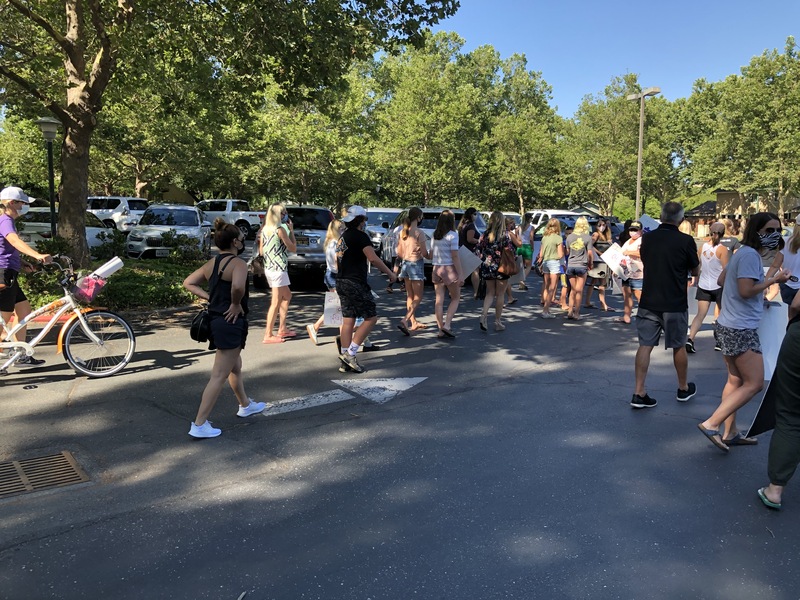 2020-06-23
2020-06-23SRVUSD Budget and Reopening Protest Photographs
These are unpublished photographs I took while reporting for my school's newspaper, The Californian. These photographs show the people who attended the protest, including a mixture of students and parents. There are also a variety of signs showing various motivations for protesting. This entry is connected to the "San Ramon community protests SRVUSD spending and issues with remote learning" submission. -
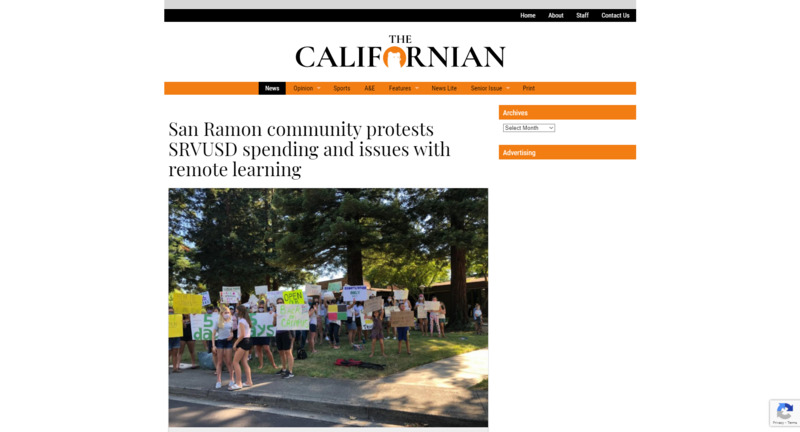 2020-06-27
2020-06-27San Ramon community protests SRVUSD spending and issues with remote learning
This is a news article I wrote about a protest for my school newspaper. The protest was convened to support the ability for students in the San Ramon Valley Unified School District to be able to return to school for the 2020-21 school year, and to oppose raises for district management and certain purchases made by the district. The protest occurred on June 23, 2020, at the SRVUSD offices in Danville, California. -
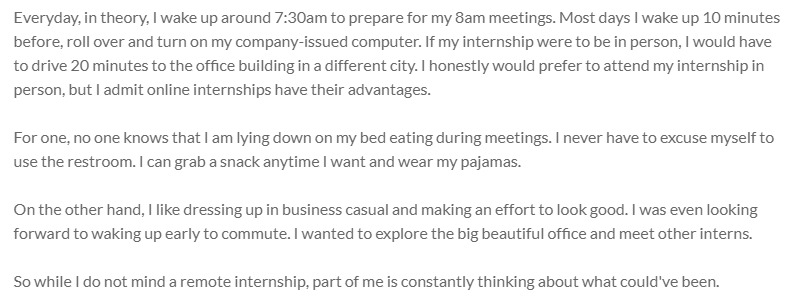 2020-05-29
2020-05-29Working Remote Internship
Everyday, in theory, I wake up around 7:30am to prepare for my 8am meetings. Most days I wake up 10 minutes before, roll over and turn on my company-issued computer. If my internship were to be in person, I would have to drive 20 minutes to the office building in a different city. I honestly would prefer to attend my internship in person, but I admit online internships have their advantages. For one, no one knows that I am lying down on my bed eating during meetings. I never have to excuse myself to use the restroom. I can grab a snack anytime I want and wear my pajamas. On the other hand, I like dressing up in business casual and making an effort to look good. I was even looking forward to waking up early to commute. I wanted to explore the big beautiful office and meet other interns. So while I do not mind a remote internship, part of me is constantly thinking about what could've been. -
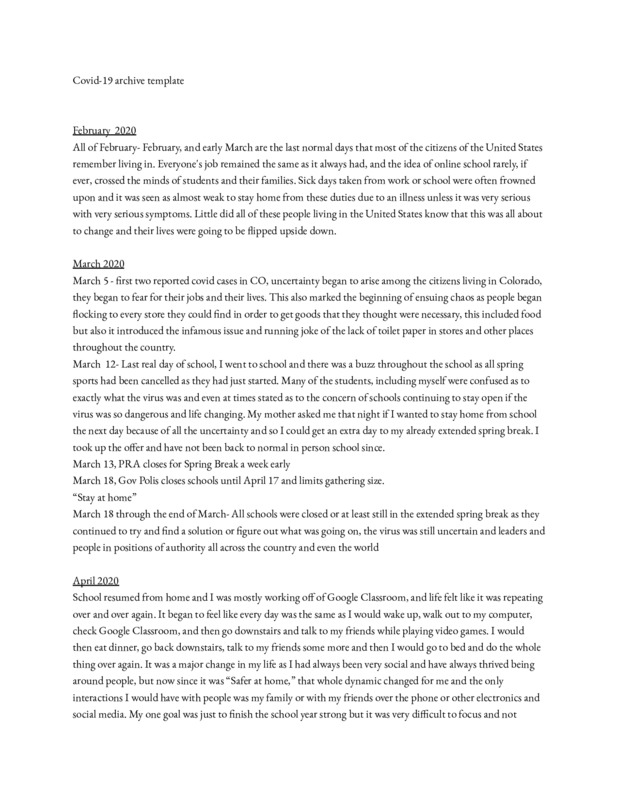 2021-05-22
2021-05-22Life as a High Schooler During Covid-19
The story talks about my experience and what it was like to be a high schooler during the pandemic and how there were many struggles involved. -
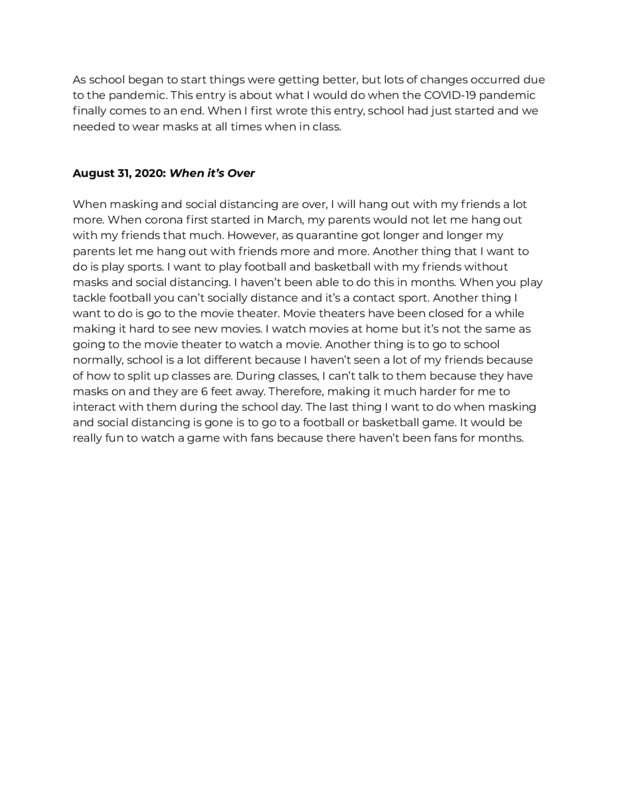 2020-08-31
2020-08-31What I Would Do After
This piece of writing explains what I wish I could do after the pandemic ends. -
 2021-05-13
2021-05-13Farewell!
My work ends here on 5/15/2021, I have curated on this website for 2 semesters at ASU and have read sad stories, funny stories, stories that are strange, and people who seem so lost, It was a nice refresher to see how people reacted to pandemic a lot more than my old job which was captioning hard of hearing people's phone calls. I heard so much more death and depressing tales there than in this archive which I find interesting but I have seen many sides of the pandemic. I did have to caption, not once but twice, old people having phone sex from that job and here have read hundred of children ponder the origin of the COVID-19 virus. It is strange but I have seen and lived many lives this pandemic thanks to my jobs. -
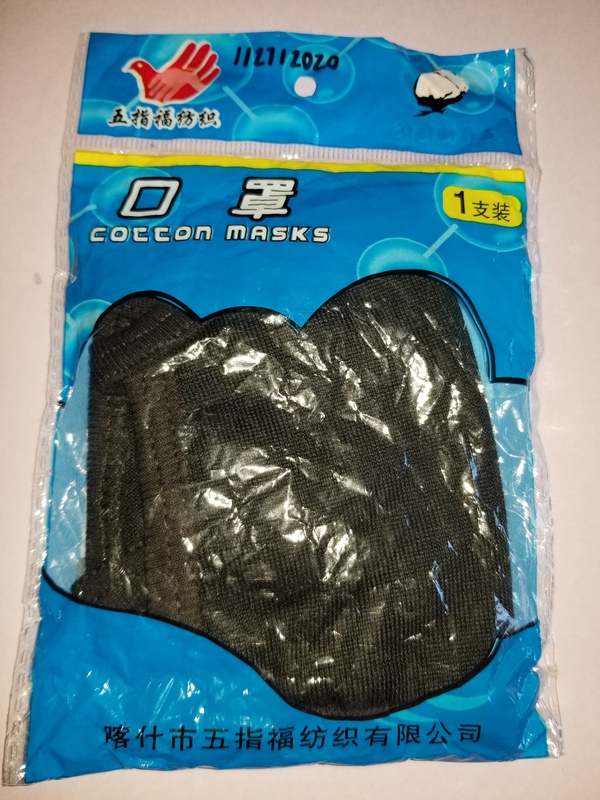 2020-01
2020-01The First Mask
This is the first mask my father gave me at the end of January 2020. We didn't think COVID-19 would be a big deal, and it was more of a precaution than anything else. When everything started shutting down, I got more masks, and lost track of this one while moving out of my college dorm. I found it in again in September of 2020, and it reminds me of just how much the world has changed. I've had two pandemic birthdays, caught COVID-19, and got my vaccines, all while trying to be a college student. Looking at this mask reminds me of how much everything has changed, and the good and bad that I've seen go along with it. -
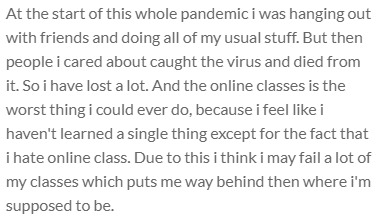 2021-05-06T03:04:26
2021-05-06T03:04:2617 year old's life during the pandemic.
At the start of this whole pandemic i was hanging out with friends and doing all of my usual stuff. But then people i cared about caught the virus and died from it. So i have lost a lot. And the online classes is the worst thing i could ever do, because i feel like i haven't learned a single thing except for the fact that i hate online class. Due to this i think i may fail a lot of my classes which puts me way behind then where i'm supposed to be. -
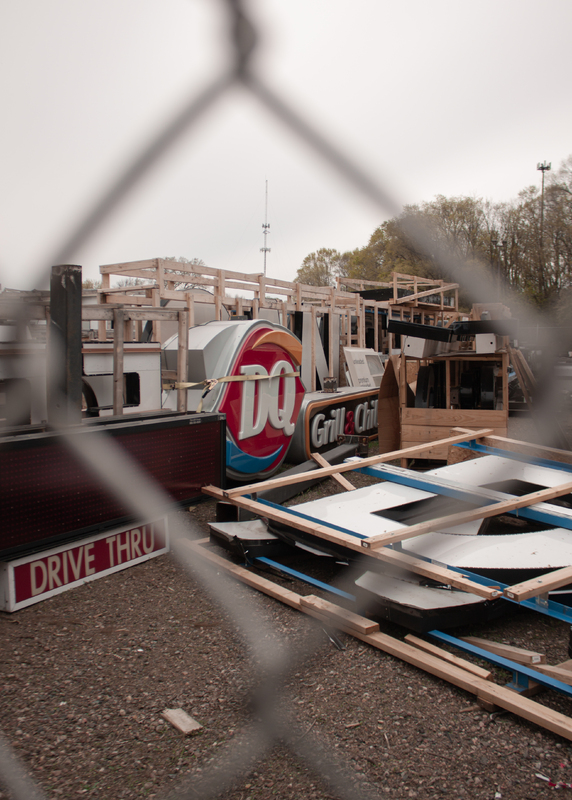 2021-04-24
2021-04-24Quarantine expiriences
For the last three or so years I have been deeply interested in photography. I enjoy photographing people and cars, though during the pandemic I have had less of a chance to go out and photograph people, that’s why I thought this would be a good chance for me to get back into the hobby and share some shots I had already captured during the pandemic. These photos have meaning behind them that remind me of all the parts of my life over the last year. A primary source is any document about a subject that was created by someone who was at the event or took part in whatever the subject is. The portfolio that I created is a primary source as it documents the first hand experiences I had while in the pandemic. It has the highs and the lows, and shows an account of one person's life in the United States of America during Covid-19. My experiences in the Pandemic were very mixed. Some parts stayed the same, some better, and some worse. Before Covid I had a small group of friends that I hung out with and when all the stay at home orders began I was able to still see them sometimes, and I never went out much so I had a very similar routine. Though one thing that I lost was car meets and races. Not only did mask ordinances make meets harder to plan but Eau Claire also began cracking down on car meets more and more. It was really tough missing out on the fun cameroudery of car meets. I work at a car audio shop and one great positive of the pandemic is that because of relief checks the shop has been constantly booked for the last 6-8 months. Another positive has been going on late night adventures with my friends. We are constantly repairing something or upgrading our cars and so when we get done it is usually late and in the last year we have begun to do fun things late at night when we get done with the daily project. The first photographs I chose was a representation of the many small businesses in the area that have been closed due to rough times during the pandemic. Many great local businesses have struggled to stay open or failed even failed to do so. The photo was taken at a storage facility for signs of businesses that have closed down in the last year or two. The photographs of cars are meant to represent the many new late night adventures that me and my friends have had during the pandemic. These trips were one of the main things that helped me cope with the pandemic and hold on to normal life just a little bit. The photo of the room is of my childhood room at my parents house. During this fall at UWEC I got a call from the school informing me I had possibly come into contact with someone and I had to quarantine for two weeks. At this same time my father contracted COVID and this meant that I was confined to this one room for my two weeks of waiting. The room became my very own jail cell, after just a few days and it was very difficult for me to pay attention in school during my quarantine. It was one of the roughest my mental health has been in my life -
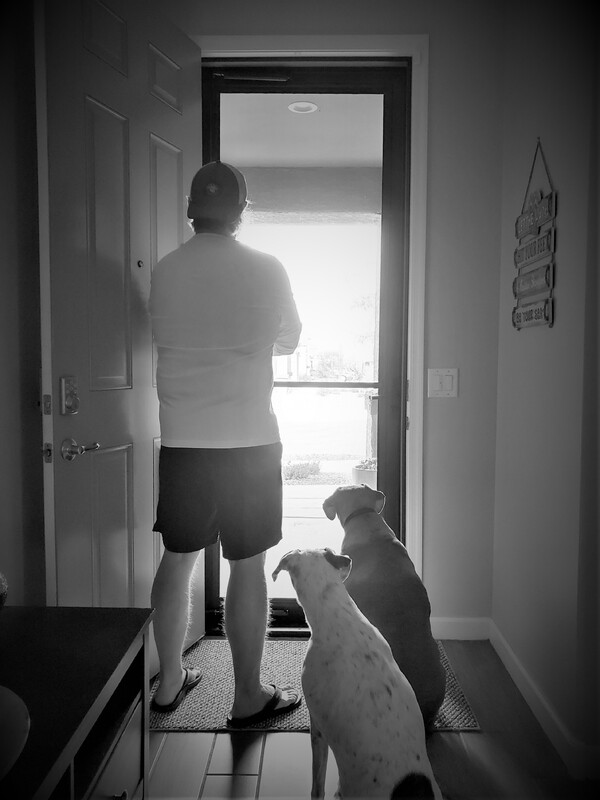 2021-04-21
2021-04-21James Rayroux's JOTPY Portfolio
--Reflections on the Pandemic Archive-- Looking back over my experience with the “Journal of the Plague Year” COVID-19 archive, my prevailing emotion is gratitude. This opportunity granted me experience that few historians earn, and the remote, asynchronous work schedule allowed me to collaborate with my colleagues in ways that maximized our respective contributions. The breadth and depth of our individual experiences and perspectives tremendously improved our collective process and products. I spent enough time in the Arizona State Archives last year to recognize such collections as historical treasure chests, but I have now participated in processing an archive’s content and navigating the ethical dilemmas those submissions sometimes create. Archivists and curators are the history profession’s truly unsung heroes, and their work facilitates society’s perception of itself. My background in police work and public safety drew me to the archive’s existing Law Enforcement collection. In taking on that subset, I succeeded in reshaping the collection’s parameters to now include stories about police and law enforcement. I wanted to diversify the collection to encompass perspective of both the police and the public with whom they interact and serve. While some overlap exists between the Law Enforcement and Social Justice collections, each remains distinct. Through my contacts and writing, I promoted a Call for Submissions to an international audience of law enforcement professionals to reduce their relative silence within the archive. Within the archive’s content, I recognized that one’s location might shape their pandemic experience, and I created and designed an Arizona-based exhibit to explore that. Further research and discussion with my mentors and colleagues ensured the exhibit illustrated these differences without excluding visitors whose diverse experiences could further enrich the archived and exhibited content. I am proud of my “Arizona’s COVID-19 Pandemics” exhibit, particularly because of its compressed, one-month incubation period. Beyond displaying images, data, and stories representative of the diverse pandemic experiences within the state, the ACP exhibit offers visitors numerous levels of interaction and engagement to became active participants and create their own exhibit experience. Visitors can complete opinion surveys, add a story to the archive, explore additional content related to the displayed pieces, view ever-changing results from pre-defined archival content searches, conduct their own archival search, view collective visitor survey results, and apply to join the staff. The exhibit’s searches will include the archive’s future submissions, which reshapes both the exhibit and the experience visitors may have with it. A more detailed explanation of my ACP exhibit may be reviewed here: https://covid-19archive.org/s/archive/item/43037 Because of Dr. Kathleen Kole de Peralta and Dr. Mark Tebeau, I stand prepared to join research, curation, and exhibition teams and immediately contribute to their work products. Despite my gratitude for this experience and the opportunities it presented, I look forward to the day COVID-19 is no longer part of humanity’s daily vernacular. James Rayroux 22 April 2021 -
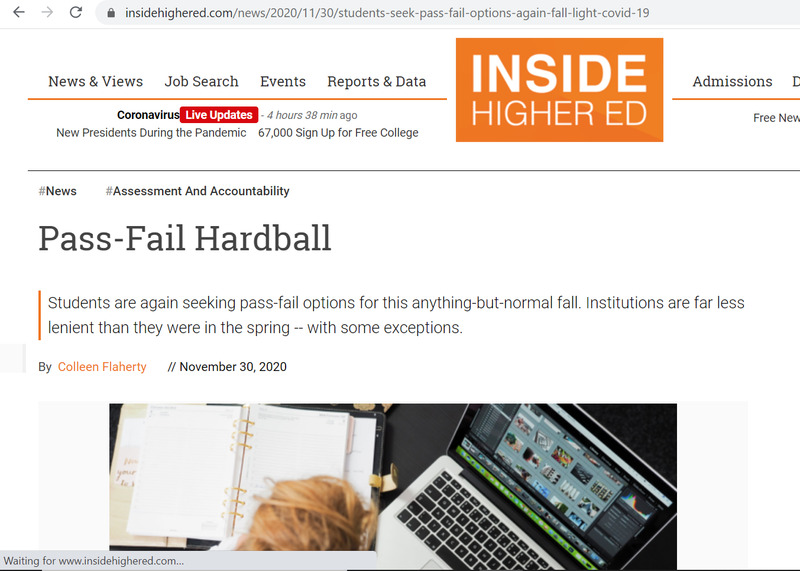 2020-11-30
2020-11-30Pass-Fail Hardball
This article talks about how, prior to the beginning of the Fall 2020 semester, some university students were seeking pass-fail grades in order to accommodate for the lack of stability during the pandemic. It discusses how several universities, such as Clemson University, the University of South Carolina, and the University of North Carolina at Chapel Hill denied their students' requests for pass-fail, while others, such as Baylor University simply acknowledged the requests and did little afterwards, all in the name of "student success". While many universities released statements saying that they understood student stress levels, they were unwilling to adapt the grading procedure to accommodate pass fail grading. -
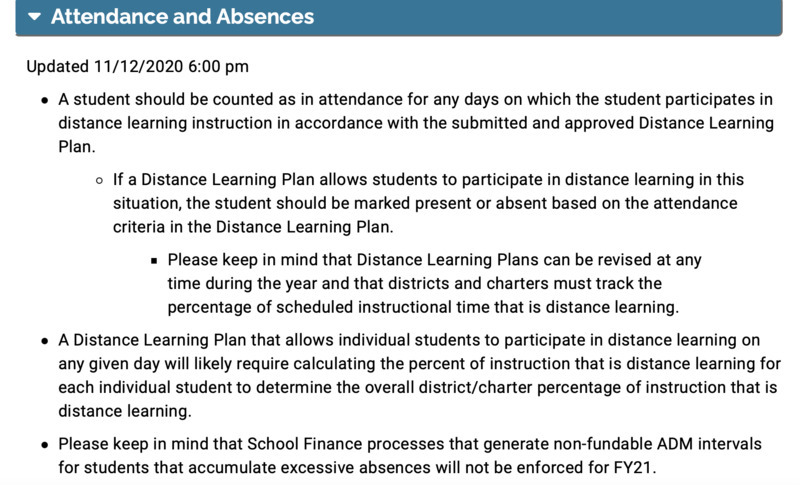 2020-10-16
2020-10-16School Finance Guidance for COVID-19
Arizona Department of Education fiscal information and guidance pertaining to attendance and absences while students participate in distance learning. The guidance page also includes links to important forms, school finance reports, and other valuable external resources. According to the report, the due date for a financial plan (Budget/AFR) is November 13, 2020. The name of the file is, "Distance Learning Report -Actual". No recent updates appear to have been made. -
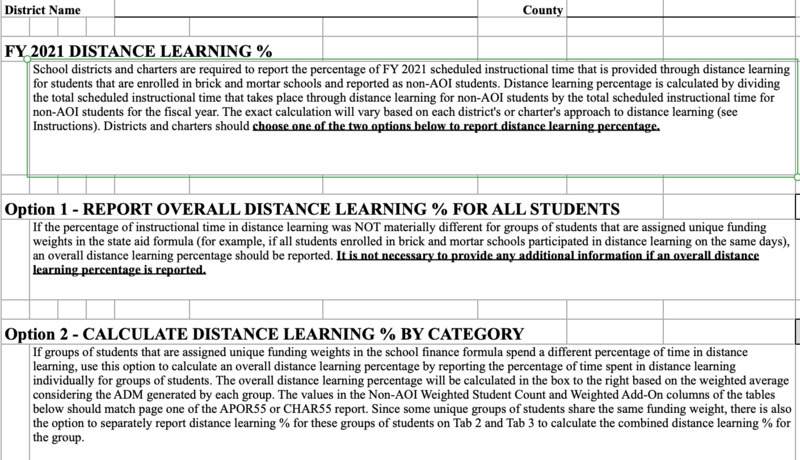 2020-10-16
2020-10-16Distance Learning Submission- FY2021
Arizona Department of Education authorizes distance learning with the passage of Executive Orders 2020-41, 2020-44, 2020-51. Students that are participating in online instruction "...shall be treated as pupils participating in Arizona Online Instruction for funding purposes." In this context, COVID-19 has impacted, on an economic level, the fabric of everyday life- down to gathering statistical data and reporting student attendance for online education for the purpose of funding virtual education, not brick-and-mortar institutions. -
 2021-03-27
2021-03-27Fox News Perspective
Living in a divided nation I felt it necessary to follow various news outlets. I've realized that many times the truth usually lies somewhere in the middle. Actually, I think the truth usually lies somewhere closer to the left side but that's beside the point. I found this post by Fox News to be interesting because it talks about how conservative TV Host Laura Ingram thinks history will be written. I rarely agree with anything Fox News posts but in this case, I agree that history will record the many villains that have been exposed during the pandemic. I agree that many special interests bodies will be listed but I don't think it will include teachers. I don't think it's farfetched to say that the conservative's push to return back to school has more to do with money and less to do with children. It's funny how she says it's time to "follow the science" where were these conservatives when science said masks help stop the spread of COVID? -
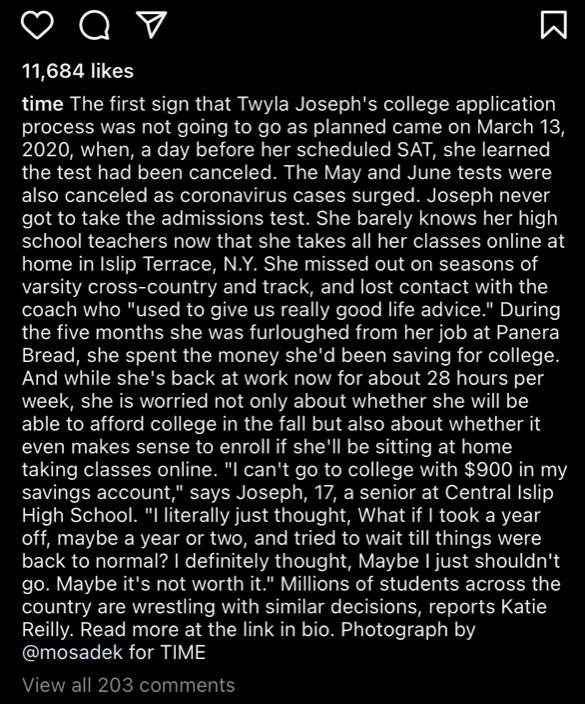 2021-04-02
2021-04-02The Lost Year: How the Pandemic Changed a Generation of Students
Time magazine explores the effects COVID-19 has had on students, especially those who spent their last year in High School dealing with quarantine and virtual learning. -
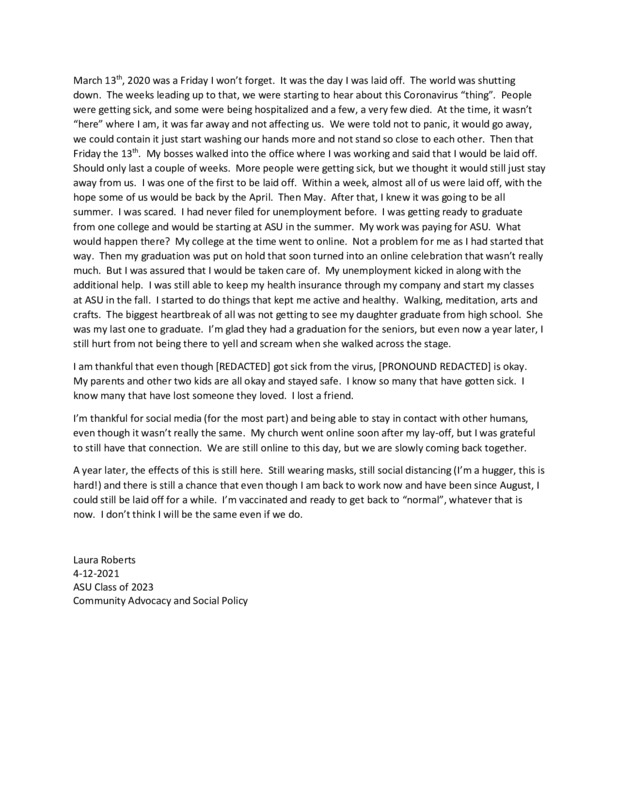 2021-03-13
2021-03-13Friday the 13th...my last day at work
This is a reflection of the first day that Covid affected me. -
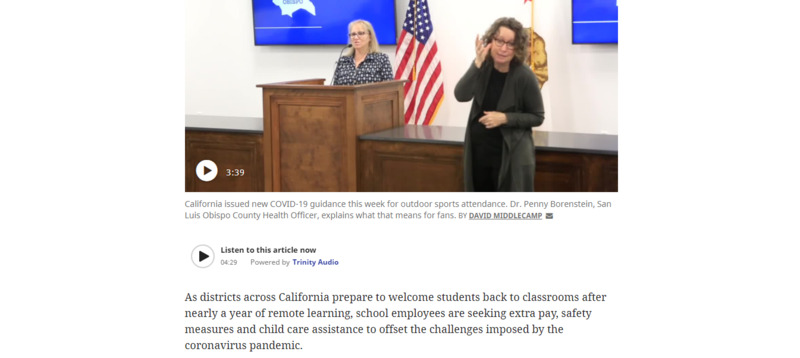 2021-04-10
2021-04-10Child Care Concerns Persist Despite Returning to In-Person Instruction in Californian Schools
Californian schools are opening back up, but there continue to be concerns over employees and their families. Although there have been some employees working at schools the past year (i.e. custodians), those working remotely (i.e. teachers) continue to face challenges in child care. Due to this, "Los Angeles Unified School District earlier this week announced it would provide a day care stipend of $500 a month for each child under age 5 to all full-time employees, including teachers." The Service Employees International Union (SEIU 1021) did clarify within the article by Sacramento Bee that some demands could not be met. Among the demands was a one-time stipend amount of $1,500 for employees with children aged 3 - 14. This is an ongoing issue with its latest update on April 10, 2021 being: a weekly stipend of $125 for employees with children aged under 14. This represents one of the issues employees of educational institutions are facing. They’re hesitant to return to in-person instruction. Although there’s a fair amount of news coverage of children returning to school, the ones hesitant (especially those responsible for the school to run smoothly) should also be acknowledged. -
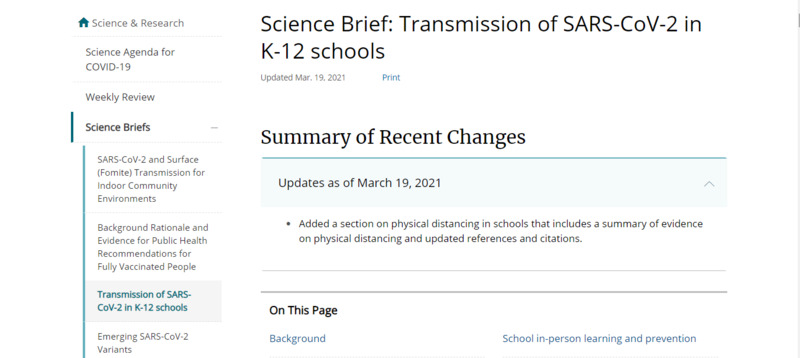 2021-04-10
2021-04-10CDC Science Brief: Transmission of COVID-19 in K-12 schools
(updated March 19, 2021) CDC report on scientific findings in terms of COVID-19, children, adolescents, and the unlikely transmission potential among these two groups (18 or younger). The experiences of other countries opening at various points during the pandemic contribute to the knowledge laid out in the report. One example of a recommended prevention strategy, physical distancing, is explained as a determining factor in preventing transmission. Yet, as the research shows, the prescribed 6-foot distance is less of a stress point when observing children and adolescents. In other words, several US studies have found low transmission rates when children are separated less than 6 feet. The same applies to children and adult interactions.
